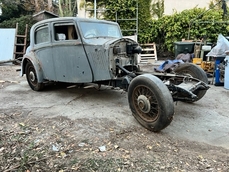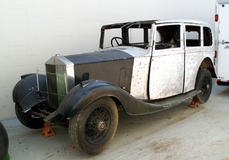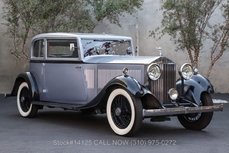Rolls-Royce 20/25 hp Shooting Brake 1930
General description :
Rolls-Royce’s 20/25 succeeded the 20 HP in 1929 as the company’s small-displacement offering positioned below the flagship Phantom models. Engineers developed a host of improvements over the outgoing 20 HP, and while this was considered an “entry model” for Rolls-Royce, it was still an exclusive, high-end automobile for a discerning clientele. The overhead-valve inline six-cylinder engine displaced 3,669 cc and featured an aluminum crankcase, cast iron cylinder block, and pressurized lubrication. It had both coil and magneto ignition systems, and the four-speed manual gearbox had a traditional right-hand gear lever position. This feature was in response to criticism from customers who complained that the central-mounted 3-speed shifter in the 20 HP models appeared cheap and thus not to the standard expected of a Rolls-Royce. The chassis of the 20/25 was a traditionally robust affair, with a solid front axle, live rear axle, semi-elliptic springs and four-wheel brakes assisted by a mechanical servo.
All of the improvements afforded the new Rolls-Royce 20/25 HP with upwards of 75 mph performance, depending upon the coachwork selected by the owner. Traditionally, Rolls-Royce sold the 20/25 as a complete chassis, less body, and customers specified their preferred coachbuilder at the time of ordering. As a result, a wide variety of 20/25s were built, ranging from formal, closed limousines to more sporting open roadsters. It was not out of the ordinary for a 20/25 to receive more than one body in its lifetime, as individual owner’s tastes evolved, and the robust chassis could easily outlive its original coachwork. It proved to be quite popular, and nearly 4,000 were built between 1929 and 1936, making the 20/25 one of the most successful Rolls-Royce models of the period.
Our featured 20/25 is a marvelous example of this versatile Rolls-Royce model and with a rich and fascinating history from new. GSR4 is a long-chassis model initially purchased in 1929 by coachbuilders Rippon Brothers, Ltd of Yorkshire, for use as a company demonstrator. Rippon was among the oldest names in the British coachbuilding business – Walter Rippon built coaches for the Earl of Rutland in 1555, and for Elizabeth I in 1564. By the 1930s, they already had a long history with Rolls-Royce. The company built its first motorcar body in 1905 atop a Rolls-Royce chassis. Rippon Bros. used GSR4 to showcase a limousine body, which was subsequently sold to Mr. Frank Broadhead, Esq. of Almondbury, Yorkshire, in May 1930. Mr. Broadhead was managing director of Kirkheaton Mills, a large wool textile mill. The car lived a relatively unassuming life at first, being chauffeur-driven exclusively by Mr. Sam Belton and used to shuttle Mr. Broadhead to work, and on company business. Its most notable passenger at the time was the future King George VI, then the Duke of York, who rode in the car during an official state visit to the mill on March 11, 1932.
Around 1939, as World War II erupted across Europe, the patriotic Mr. Broadhead enlisted his faithful Rolls-Royce to assist the war effort. The military unceremoniously scrapped the rear limousine section of the body and replaced it with a purposeful, albeit inelegant, ambulance body. Chassis GSR4 was put into service transporting sick and wounded soldiers from the local train station to the hospital, reportedly performing its critical duties without fault.
After the war, the car returned to the possession of Broadhead and the Kirkheaton Mill. The ambulance body was removed, and in its place, a more suitable shooting brake body was fitted. Credit for the coachwork goes to S. Pexton & Son, or more specifically, Harold Pexton, who directed woodworker Reuben Metcalf and blacksmith Leslie Walshaw to frame and skin the body. It then returned to service at the mill as a high-end delivery vehicle, transporting wool goods to clients and guests to picnics in the countryside. A promotional postcard in the history file shows GSR4 leaving the gates at Buckingham Palace, presumably after a delivery. All along, the loyal company chauffeur Sam Belton remained at the helm. So meticulous was Belton in his care for the Rolls that it turned a half-million miles while serving as the mill’s delivery vehicle.
In the 1960s, Mr. Roger LaViale purchased GSR4 and brought it to the USA via Cunard Lines “RMS Scythia.” LaViale was also in the textile business, and he used the Rolls-Royce as a promotional tool to spread the word about quality English wool, going so far as to hire Belton to drive the car to various high-end department stores around the US. With the tour completed, he sold the car to Mr. Waterman of Nashville, TN, in 1967. In 1972, Dr. Sessions of Marietta, Georgia acquired it. Dr. Sessions had been aware of the car for a few years and was fascinated by its unique coachwork. He became a passionate custodian of GSR4 for nearly five decades and spent many years tracing the car’s history, going so far as to travel to Yorkshire to interview former mill employees who recalled the Rolls when it was in service.
In 1973 a leaky radiator took the car off the road, which led to a 30-year restoration project (as these things sometimes do). Finally, in 2003, the restoration was declared “complete,” and the Sessions family proudly showed GSR4 at numerous RROC concours events and gatherings. It debuted at the RROC Newport meet in 2003, scoring an impressive 387 of 400 points.
Today, it presents in excellent condition throughout, thanks to the meticulous restoration and care. In place of the previous single-tone maroon color is this attractive maroon and cream livery, which suits the coachwork marvelously. Despite the obscurity of the coachbuilder, the quality is superb, with plenty of intriguing details, accentuated by the high-quality restoration. The interior woodwork is beautiful, and the spacious rear compartment includes a pair of clever side-facing jump seats that fold into the floor, and integrated wood cabinets complete with picnic china. The front compartment upholstery is preserved, except for only the driver’s seat squab, which has been reupholstered. Switches and controls are correct, as are the original instruments.
Incredibly, after more than 500,000 miles, GSR4 still retains its original engine per the factory build sheets. It runs beautifully, and the car feels impressively tight on the road, making this Rolls-Royce is an excellent choice for touring, RROC gatherings, or simply for picnics in the countryside. This beautiful, one-off shooting brake has a truly fascinating story, and it is ready for a new caretaker to add the next chapter.
Offers welcome and trades considered
https://hymanltd.com/vehicles/6585
1930 Rolls-Royce 20/25 hp Shooting Brake is listed sold on ClassicDigest in St. Louis by Mark Hyman for $79500.
Car Facts
Car type : Car Make : Rolls-Royce Model : 20/25 Model Version : hp Shooting Brake Engine size : 0.0 Model Year : 1930 Sub type : Station wagon Location : Missouri
Sold
Seller Information
Sold
People who viewed this Rolls-Royce 20/25 also viewed similar Rolls-Royce listed at ClassicDigest
Other cars listed for sale by this dealer
About Rolls-Royce
Well, ladies and gentlemen, today we're diving into the illustrious history of a brand that has always embodied the very essence of British luxury and craftsmanship - Rolls-Royce.Our story begins at the turn of the 20th century when two visionaries, Charles Rolls and Henry Royce, decided to join forces. In 1904, the very first Rolls-Royce was born, the Rolls-Royce 10 hp. It was a modest start for a company that would go on to redefine automotive excellence.
But it wasn't until 1907 that Rolls-Royce truly made its mark with the introduction of the Silver Ghost. It was hailed as the "Best Car in the World" and set the gold standard for luxury motoring. With its whisper-quiet engine and exquisite craftsmanship, it was a statement of opulence and refinement.
The 1920s brought us the Rolls-Royce Phantom I, an icon of its time. It was the first Rolls-Royce to feature a 6-cylinder engine and set the stage for the legendary Phantom line. This was the era when the Maharajas of India commissioned custom-bodied Rolls-Royces that were nothing short of automotive palaces.
Fast forward to the post-war years, and we have the Silver Cloud, a symbol of post-war British optimism. The Silver Cloud was elegance personified, with its flowing lines and handcrafted interiors. It was the choice of royalty, celebrities, and captains of industry.
But if we're talking about the epitome of Rolls-Royce luxury, it's the Rolls-Royce Phantom VI, which graced us with its presence from 1968 to 1991. This was a car that made the statement that "if you have to ask the price, you can't afford it." Customization was the name of the game, and the Phantom VI was a canvas for the world's wealthiest to express their unique tastes.
Now, it's impossible to discuss Rolls-Royce without mentioning the Rolls-Royce Corniche. Produced from 1971 to 1995, it was a convertible and coupe version of the Silver Shadow. The Corniche was the quintessential grand tourer, a car for those who wished to traverse continents in absolute luxury.
But, alas, even the mightiest must face their decline, and Rolls-Royce was no exception. The company went through financial turmoil in the 1970s and 80s, leading to the takeover by Vickers plc. Then came the controversial BMW and Volkswagen ownership period, which divided enthusiasts.
Rolls-Royce regained its footing under BMW ownership, and the new millennium brought us the Rolls-Royce Phantom VII, a return to the company's roots of uncompromising luxury. The Phantom VII was a testament to British engineering and craftsmanship.
And that, ladies and gentlemen, brings us to today. Rolls-Royce continues to produce some of the most opulent, bespoke vehicles on the planet, a symbol of British imperiousness that has not waned with time. The spirit of Sir Henry Royce and Charles Rolls lives on in every car that bears the Spirit of Ecstasy, a testament to the enduring legacy of British automotive excellence.











